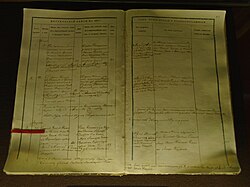
Marriage records typically include detailed information about the bride and groom, such as their full names, dates of birth, places of birth, residences, and occupations. These records also include the date and place of the marriage, as well as the names of witnesses, who were often close relatives or friends. In many cases, marriage records from the Soviet era onward include information about the parents of the bride and groom, including their names and sometimes their occupations. Modern marriage records in Russia have evolved to meet the needs of a contemporary society, blending tradition and bureaucracy. These records are maintained by the government and continue to play a crucial role in legal, social, and genealogical contexts.
Research your ancestors on MyHeritage
History of marriage certificates in Russia
Pre-Imperial Russia
Before the formal establishment of the Russian Empire, marriages in the territories that make up modern Russia were often recorded in church registers. The Russian Orthodox Church held significant sway, and many aspects of daily life, including marriages, were closely tied to religious traditions.
Church recorded marriages
Church records, particularly in Orthodox Christianity, played a central role in recording marriages. They were meticulously maintained by priests and included information such as:
- names of the bride and groom
- names of their parents
- marriage date
- location where marriage took place
These church records provide a treasure trove of genealogical information and cultural insights, including details about naming conventions, religious practices, and family relationships.
Imperial Russia
As the Russian Empire grew, the state began to take a more active interest in record-keeping. Imperial Russia saw the introduction of state-run civil registration offices (ZAGS) for recording vital events, including marriages. These civil marriage records were maintained alongside church records, offering an alternative source of information for genealogists. The state records often included more secular information, such as occupations and addresses.

Soviet Era and civil registration
The Soviet Era brought significant changes to the marriage registration process. The Soviet government aimed to secularize and standardize marriage practices. Civil marriage ceremonies became the norm, and marriage records took on a more uniform and bureaucratic format. Civil registration offices, or ZAGS, became responsible for marriage records, further separating church and state affairs.
Access and availability
Marriage records from the pre-Soviet and Soviet Eras are typically accessible through state archives, local ZAGS offices, and online databases. These records are considered public and open for research purposes. Access to church records can vary, as these records may be preserved in local parishes, regional archives, or digitized in online databases.
Centralized registration
In contemporary Russia, marriage records are maintained through a centralized system of civil registration offices, known as ZAGS (ЗАГС). ZAGS offices are present in every region, city, and district, ensuring that marriage registrations are accessible to the entire population.
Official procedure of marriage in Russia
Legal requirements
To get married in Russia, couples must follow a set of legal procedures. This includes submitting a formal application to the local ZAGS office, providing necessary documents, and attending a civil marriage ceremony. Required documents typically include passports, proof of dissolution of any prior marriages, and, if applicable, a certificate of name change.
Civil marriage ceremonies
Civil marriage ceremonies are the standard in Russia. While religious ceremonies are allowed, they are not legally binding, and couples must still register their marriage with ZAGS. Civil ceremonies are relatively straightforward, often taking place in a ZAGS office or a location approved by the office. They involve exchanging vows and signing the marriage registry.

Marriage certificates
Upon successfully registering their marriage, couples receive a marriage certificate (Свидетельство о браке). This document is an official record of their marriage and is required for various legal and administrative purposes.
Marriage records information
The marriage certificate typically includes essential information, such as the names of the bride and groom, their dates and places of birth, their parents' names, and the date and location of the marriage. It may also note any name changes.
How to gain access to marriage certificates in Russia
Data privacy and access
Like most countries, Russia has data privacy laws that protect the personal information of individuals. Access to modern marriage records may be subject to certain restrictions and privacy concerns, particularly for records of living individuals.
Digitalization and online access
Many ZAGS offices have embraced digitalization, making marriage records available online. This has streamlined the process of obtaining copies of marriage certificates for individuals conducting genealogical research.
Variations by region
It's important to note that the specific procedures and documentation requirements for marriage registration can vary slightly by region. Different regions may also offer varying degrees of online accessibility to marriage records.
It’s important to note, that in order to obtain a marriage certificate of your ancestors, you should have the entire chain of documents showing your relationship to the ancestor, including his/her death certificate.
See also
Explore more about marriage records in Russia:
- Russia, Marriages, 1793-1919 at MyHeritage
- Marriage Records: Everything You Need to Knowat MyHeritage Blog


